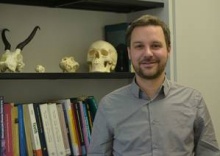The functional, developmental and adaptive base of mammalian skull and tooth morphology

Kornelius Kupczik
Max Planck Weizmann Center for Integrative Archaeology and Anthropology, Max Planck Institute for Evolutionary Anthropology, Leipzig, Germany kornelius_kupczik@eva.mpg.de
(Seminar in English)
Mammals show a high degree of diversity in skull and tooth morphology. Yet, while the bones of the skull can respond plastically throughout ontogeny, the cusps of teeth do not. Here I will present 1) how changes in muscle function affect both the external morphology and the internal bone microstructure of the craniofacial skeleton in different mouse models; and 2) what we can learn from hairless dogs about the genetic mechanisms underlying specific dental character-state transitions observed within and across mammalian lineages.
Recent publications:
Spassov, A., Toro-Ibacache, V., Krautwald, M., Brinkmeier, H., Kupczik, K. (2017) Congenital and induced changes in muscle function affect skull morphology differentially. Journal of Anatomy 231: 736-748
Kupczik, K., Cagan, A., Brauer, S., Fischer, M.S. (2017) The dental phenotype of hairless dogs with FOXI3 haploinsufficiency. Scientific Reports 7: 5459.
Balanta-Melo, J., Torres-Quintana, M.A., Bemmann, M., Vega, C., González, C., Kupczik, K., Toro-Ibacache, V., Buvinic, S. (2018) Masseter muscle atrophy impairs bone quality of the mandibular condyle but not the alveolar process early after induction. Journal of Oral Rehabilitation in press.


